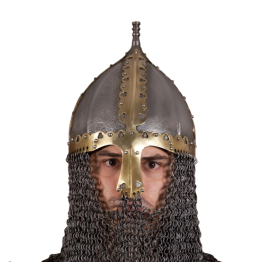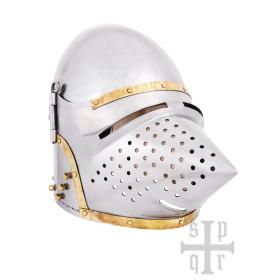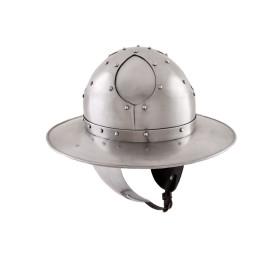Helmets
There are 219 products.
Tenth Century Gnezdovo Viking Varangian Rus Slavic Helmet 16th Gauge
Our reproduction is directly inspired by an original found in a tenth-century Slavo-Varghian settlement called Gnezdovo or Gnyozdovo, near Smolensk in present-day Russia. Many typical Scandinavian objects have been found simultaneously with this helmet, making it a good choice for those who want to recreate a Viking/Varangian/Russian/East Slavic character. However, this helmet may not be suitable if it depicts a western Viking raiding England.
This helmet is HANDMADE from 1.6mm mild steel (16 gauge) and lined with an adjustable genuine leather lining. From it hangs a riveted chain mail that protects the lower part of the face. An approximate circumference of 68 cm (unlined) (65 cm with lining) allows it to fit most head circumferences from about 58 cm to 61-62 cm, depending on the shape of the wearer's head. (If you want to wear an extra padded hat, measure the circumference of your head while wearing it.) A genuine leather chin strap, with solid brass buckle, keeps you in place battle after battle. It has a height of about 25.5 cm (without aventail), the internal width at ear level is about 21 cm and the internal depth from front to back at eye level is about 24.5 cm. It weighs about 4 kg and 12 grams.
Note: This product is carefully coated with a layer of oil when packaged that acts as a temporary (protective) layer against corrosion (rust), which can be easily cleaned with any degreasing product or even with a dry cloth.
This helmet is HANDMADE from 1.6mm mild steel (16 gauge) and lined with an adjustable genuine leather lining. From it hangs a riveted chain mail that protects the lower part of the face. An approximate circumference of 68 cm (unlined) (65 cm with lining) allows it to fit most head circumferences from about 58 cm to 61-62 cm, depending on the shape of the wearer's head. (If you want to wear an extra padded hat, measure the circumference of your head while wearing it.) A genuine leather chin strap, with solid brass buckle, keeps you in place battle after battle. It has a height of about 25.5 cm (without aventail), the internal width at ear level is about 21 cm and the internal depth from front to back at eye level is about 24.5 cm. It weighs about 4 kg and 12 grams.
Note: This product is carefully coated with a layer of oil when packaged that acts as a temporary (protective) layer against corrosion (rust), which can be easily cleaned with any degreasing product or even with a dry cloth.
€202.98
Houndskull Bascinet, Medieval Helmet, ca. 1370, 1.6mm Steel
The houndskull (German: Hundsgugel), a variation of the late medieval bascinet, enjoyed great popularity among knights and warriors throughout Europe until about 1420. It owed its name to the characteristic design of its visor, which featured a "snout" protrusion that resembled the face of a dog (hound, or in German: Hund). Pig-faced Bascinet is another term sometimes used to refer to this specific type of medieval helmet.The helmet with visor we offer here is based on original examples from the fourteenth century (ca. 1370 AD). It is manufactured from approx. Steel is 1.6 mm thick and is equipped with a hinged and fully removable face shield that is securely fixed in position with pins and reinforced with riveted brass straps. This visor has two approx. Eye slits 9 cm long and 0.6 cm wide, plus numerous round cutouts on the right side and two smaller slits at mouth height for proper ventilation.The sides and bottom edge of the helmet bowl are studded with so-called vervelles made of brass. These small protruding rivets with holes allow the addition of aventail or camail chainmail (not included in delivery).The interior is tinted for better corrosion resistance and has an adjustable linen fabric lining that is attached to the rim of the bowl with sturdy stitches.This fully wearable knight helmet is best suited for late Middle Ages scenarios and ideal for completing the Armor of a European warrior. It will make your transformation into a proud knight seamless and makes a great decorative addition to any helmet collector's treasure chamber.Details:- Material: 1.6 mm steel (visor approx. 1.2 mm), brass fittings, linen inlays- Suitable for head circumference up to approx. 63 cm- Long distance (from back to front): approx. 21 cm- Short distance (ear to ear): approx. 19 cm- Height: approx. 26 cm- Weight: approx. 3200 gSpecifications may vary slightly from part to part.The steel used here is not rust-proof and may have slight surface stains in places. We recommend that you regularly maintain helmets, for example using Ballistol Universal Oil, which is ideal for taking care of steel.
€150.00
Kettle hat with cheek guards, 1.6mm steel
The kettle hat or war hat, a fairly simple helmet shaped like a brimmed hat, came into fashion in the 13th century and enjoyed great popularity among foot soldiers, archers, crossbowmen, pikemen, and men-at-arms throughout Europe until the fifteenth century. It owes its name to its resemblance to a saucepan (originally called a kettle).While kettle hats existed in many variations, they all shared the same main feature: a wide brim that offered protection against downward sword strikes and projectiles fired or dropped from above, without impairing the wearer's vision, hearing, or breathing. This design proved useful during sieges and mass infantry battles and contributed primarily to the enduring prevalence of this type of helmet. The so-called sallet developed from the kettle hat in the fifteenth century.This reconstruction of a late medieval kettle hat is made of 1.6mm (16 gauge) steel. The edge of the flap is wrapped all the way around and four bands or plates (in German called Spangen) are arranged decoratively in the shape of a cross on the bowl of the helmet. In the overlapping areas, the thickness of the material is more than 5 mm. Dark brown leather straps with aged brass buckle are riveted to the two cheek guards.The interior is blacked out for better corrosion resistance. It is equipped with an adjustable padded lining made of high-quality black fabric and fastened with rivets. Suitable for light combat staging, LARP, stage or TV/film, this wearable helmet is best suited for late Middle Ages scenarios and ideal for completing the armor of a European warrior. Of course, it will also be a great addition to any helmet collector's treasure chamber.
€170.00

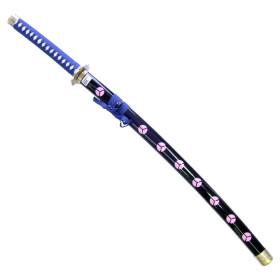

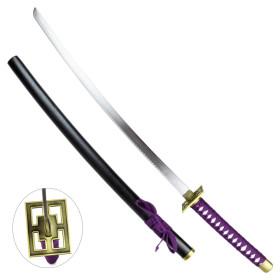


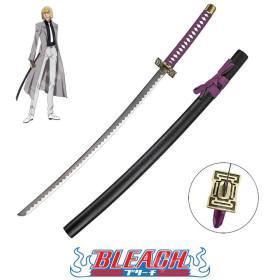
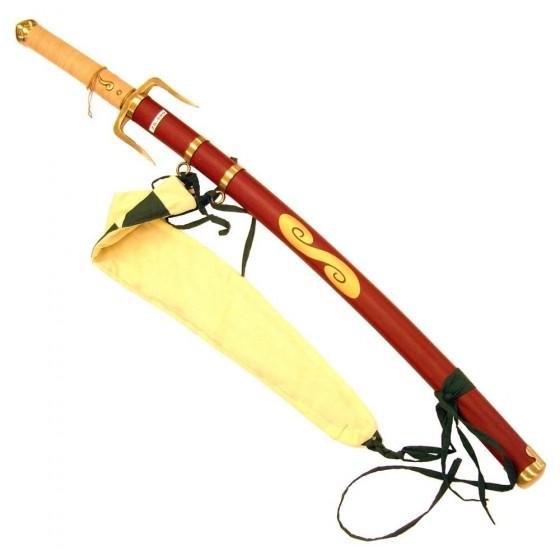


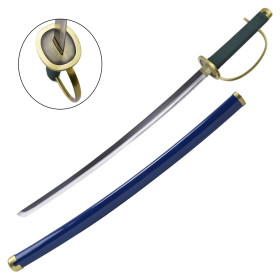
 (280 × 350 px) (1)_2.png)
.png)
